The WildLife: Tiger Farming & Tiger Trade, Grace Ge Gabriel
Grace Ge Gabriel, Asia Regional Director for the International Fund For Animal Welfare (IFAW), discusses tiger farming and the international tiger trade. She reveals to “The WildLife” host Laurel Neme how the international trade in tiger parts works and why it has spawned a booming industry of tiger farming in China that is truly killing to make a living. After joining the International Fund for Animal Welfare in 1997, Grace Ge Gabriel established the IFAW China office where she managed and directed an array of wildlife conservation campaigns and projects in China and Asia. For over a decade, she’s been actively involved in the global campaign to end the tiger trade and has personally investigated the illegal trade in tiger parts and derivatives. She’s also spearheaded numerous campaigns, including those to protect Tibetan antelope, reduce trade of wildlife and products including bears, tigers, elephants, and others that improved the status of companion animals through legislation and education. She’s also been involved in projects to conserve Asian elephant habitat, provide emergency relief to animals in disasters and establish China’s first raptor rescue center. She was born and grew up in China. She received her degrees in journalism and communications both in China and the United States. She is fluent in both Mandarin Chinese and English. This episode of “The WildLife” aired on The Radiator, WOMM-LP, 105.9 FM in Burlington, Vermont on March 15, 2010.
Article and transcript available below and on Mongabay.com.

Tiger farming and traditional Chinese medicine
By Laurel Neme, special to mongabay.com
June 27, 2010
 Grace Ge Gabriel, Asia Regional Director for the International Fund for Animal Welfare (IFAW) spoke with Laurel Neme on her “The WildLife” radio show and podcast about tiger conservation the international trade in tiger parts, and how the booming industry of tiger farms in China is killing to make a living.
Grace Ge Gabriel, Asia Regional Director for the International Fund for Animal Welfare (IFAW) spoke with Laurel Neme on her “The WildLife” radio show and podcast about tiger conservation the international trade in tiger parts, and how the booming industry of tiger farms in China is killing to make a living.
This interview originally aired March 15, 2010. The interview was transcribed by Jordan Schaul.
The number of wild tigers has plummeted from 25,000-30,000 animals 50 years ago to around 3,200 today. A large part of the drop is from habitat loss and fragmentation. Tiger habitat has been reduced by 40 percent over the last decade, and tigers now occupy less than 7 percent of their historical range. Poaching has also contributed significantly to these dramatic population declines, particularly to supply parts for use in traditional medicine.
Tiger parts have been used in traditional Chinese medicine (TCM) for centuries. Tiger bones treat ulcers, typhoid, malaria, dysentery, burns and even rheumatism. Other parts, like its whiskers, are worn as talismans or protective charms or used to sooth toothaches. Its penis is sold as a sexual tonic, and its skin is valued as a trophy or worn in clothing as a symbol of wealth.
China has a domestic law to ban the tiger bone trade and it is a signatory of the Convention on International Trade in Endangered Species (CITES), which prohibits international commercial trade in tiger parts. However, critical legal “grey” areas exist, most notably the allowance of captive breeding. As a result, today China has over 6,000 captive-bred tigers living on tiger farms.
In her interview, Grace Ge Gabriel notes that, although the Chinese government has made significant efforts to reduce demand for tiger products by eliminating tiger bone from the official pharmacopeias, raising consumer awareness and identifying cheaper and more effective herbal alternatives to tiger bone for use in TCM, tiger farms threaten to reopen demand for tiger products by breeding tigers excessively, stockpiling tiger carcasses, and stoking demand by making and selling wine made from tiger bone.
Grace Ge Gabriel is the Asia Regional Director for the International Fund for Animal Welfare (IFAW). After joining IFAW in 1997, Grace established the IFAW China office which was the first and only animal welfare organization operating in Mainland China. There, she managed and directed an array of wildlife conservation campaigns and projects in China and Asia.
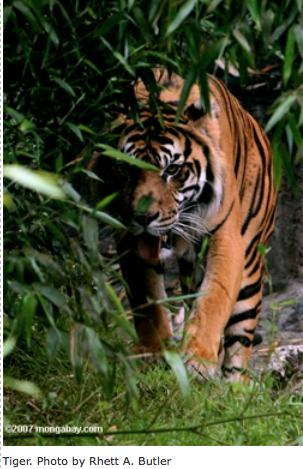 For over a decade Grace has been actively involved in the global campaign to end the tiger trade and has personally investigated the illegal trade in tiger parts and derivatives. She’s led IFAW’s China program which provides strategic support to the organization’s overall mission of reducing commercial exploitation of wildlife, preserving wildlife habitat, and helping animals in crisis and distress. She’s spearheaded numerous campaigns, including those to protect Tibetan antelope, reduce trade of wildlife and products, including bears, tigers, elephants and others and also campaigns that improve the status of companion animals through legislation and education. She’s also been involved in projects to conserve Asian elephant habitat, provide emergency relief to animals in disasters, and helped establish China’s first raptor rescue center. Grace was born and grew up in China. She received her degrees in journalism and communications both in China and the United States. She’s fluent in both Mandarin Chinese and English.
For over a decade Grace has been actively involved in the global campaign to end the tiger trade and has personally investigated the illegal trade in tiger parts and derivatives. She’s led IFAW’s China program which provides strategic support to the organization’s overall mission of reducing commercial exploitation of wildlife, preserving wildlife habitat, and helping animals in crisis and distress. She’s spearheaded numerous campaigns, including those to protect Tibetan antelope, reduce trade of wildlife and products, including bears, tigers, elephants and others and also campaigns that improve the status of companion animals through legislation and education. She’s also been involved in projects to conserve Asian elephant habitat, provide emergency relief to animals in disasters, and helped establish China’s first raptor rescue center. Grace was born and grew up in China. She received her degrees in journalism and communications both in China and the United States. She’s fluent in both Mandarin Chinese and English.
Laurel Neme: What is the importance of the tiger in Chinese culture?
Grace Ge Gabriel: There are two animals in Chinese culture that are very, very significant: one is the dragon and one is the tiger.
Laurel Neme: What do they symbolize?
Grace Ge Gabriel: They both symbolize strength, power, beauty and charm. The difference is [that the] tiger is an animal that’s a real animal and it is still an existing animal. The tiger is also in the Chinese zodiac. Every 12 years a tiger year comes along, and in fact we just got into a new year of the tiger. Particularly in the year of the tiger a lot of people would want to have children born in The Year of the Tiger because it is a very auspicious year, it is a very auspicious symbol. Tiger images were written in Chinese literature and in Chinese art. It’s very significant. It is part of the Asian culture, and it’s not just Chinese. The tiger is a species that only existed in Asia. It’s kind of a pride of the Asian continent.
Laurel Neme: What is the conservation status of tigers? You said tigers exist only in Asia. How many are there, and what kinds are there?
Grace Ge Gabriel: Estimates a century ago said there are probably about 100,000 tigers that range across Asia all the way to the Caspian Sea… Now, their habitat has shrunk to less than 7% of their original range and the numbers have been declining drastically, particularly in the last ten years [when] tiger numbers have come down to perhaps 3,200 left in the wild.
Laurel Neme: Where are they and what are the remaining subspecies?
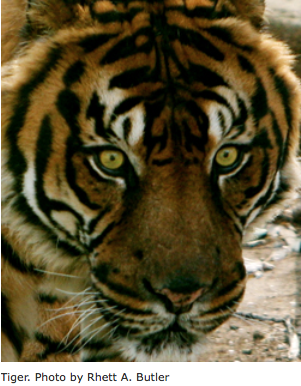 Grace Ge Gabriel: There are still tigers in 13 range states in Asia and the remaining subspecies are scattered in these range states from Russia’s Far East to [areas] bordering with China, to South East Asia (Vietnam, Laos, Cambodia, Thailand), to South Asia (Bhutan, Myanmar, India, Malaysia, Indonesia)… There is the Bengal tiger, in India (which may have about half of the remaining wild tiger population) and Nepal, … Indo-Chinese tiger in Southern China bordering with Vietnam, Laos, Thailand, Myanmar, … and also the Amur tiger. A lot of people know Amur tiger by their other name, Siberian tiger, but they really don’t live in Siberia, per se…
Grace Ge Gabriel: There are still tigers in 13 range states in Asia and the remaining subspecies are scattered in these range states from Russia’s Far East to [areas] bordering with China, to South East Asia (Vietnam, Laos, Cambodia, Thailand), to South Asia (Bhutan, Myanmar, India, Malaysia, Indonesia)… There is the Bengal tiger, in India (which may have about half of the remaining wild tiger population) and Nepal, … Indo-Chinese tiger in Southern China bordering with Vietnam, Laos, Thailand, Myanmar, … and also the Amur tiger. A lot of people know Amur tiger by their other name, Siberian tiger, but they really don’t live in Siberia, per se…
Laurel Neme: What factors contribute to the tiger’s decline?
Grace Ge Gabriel: Tigers are threatened by habitat loss and habitat fragmentation. As I said the tiger’s range has shrunk to less than 7 percent of it’s historical domain and a lot of its habitat is cut-off, fragmented, by agriculture development activities, and so that is one of the big threats to tigers. And another threat is loss of prey. As top predators tigers rely on a lot of hoofed animals, ungulates, to survive, and because in a lot of the forest hoofed animals are being hunted or poached and people kill them, tigers lost their prey. If they don’t have enough food, of course, they can’t survive. And another more direct and I believe a more menacing threat to tigers is poaching of tigers for the trade in parts and derivatives.
Laurel Neme: What are tigers used for? Why are they poached so much?
Grace Ge Gabriel: Because one of the tiger’s attributes is power and strength, historically tiger bone was used in traditional Chinese medicine. Three thousand years ago, for instance, Chinese medicine’s Materia Medica included tiger bone as an ingredient for treating illnesses such as rheumatism. But since the 1990s China has banned the use of tiger bone in traditional Chinese medicine and has taken tiger bone off the Materia Medica and also taken off tiger bone off of the traditional Chinese medicine college curriculum. The Chinese government actually has conducted public awareness campaigns and targeted the TCM industry to dissuade the use of tiger bone, and that has effectively contained the market in China, at least the market for using tiger bone in traditional Chinese medicine.
Laurel Neme: Has it stopped the practice?
Grace Ge Gabriel: Because of its historical use, there are a lot of people who still believe … in tiger bone. That belief is hard to kill.
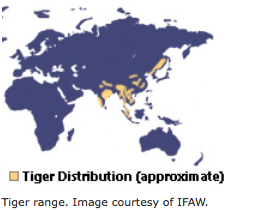 Laurel Neme: Have scientists found that it is true that it does help, or has there been no evidence yet, or has it not been studied?
Laurel Neme: Have scientists found that it is true that it does help, or has there been no evidence yet, or has it not been studied?
Grace Ge Gabriel: It has been studied, actually. In one of the efforts since China banned the use of tiger bone in TCM, it looked for alternative ingredients. By looking for alternative ingredients you need to know what actually is contained in tiger bone. Research has found that what is contained in tiger bone is calcium, and there has been a lot of alternative ingredients, even calcium tablets, that have been effectively used in treating bone ailments and pain and things like that. So it’s definitely not absolutely necessary to use tiger bone to treat rheumatism.
Laurel Neme: We hear a lot about tiger bone wine. Is that just another use of tiger bone or is that more of a luxury product?
Grace Ge Gabriel: This is the gist of the issue. Since the TCM market has been contained by the government trade ban, unfortunately there are corporations that farm tigers. They speed breed tigers and then kill them to produce a new product, which is this tiger bone wine. They soak tiger bone in liquor and sell this tiger bone wine to consumers who have this belief that somehow eating tiger parts is good for them. What this trade is doing is creating a new market for tiger products. [Because] the TCM market has been reduced, now they are creating another market for a new product. It’s a product looking for a market… In the past two months, we have seen a lot of these tiger farm businesses stepping up their marketing trying to sell tiger bone wine not only on the premises of the farm but also online and in retail outlets in other cities in China. What they are doing is trying to create a demand. It’s a product looking for a market. And they are trying to create a demand and make a killing just ahead of the year of the tiger.
Laurel Neme: So how many tiger farms are there and how many tigers are in them?
Grace Ge Gabriel: According to Chinese government documents that they submitted to CITES right now there are over 6,000 tigers in various farms. Most of them are very small, and I wouldn’t even call them tiger farms. Some of them are just zoos that also raise tigers in the hope that they will be able to trade them. But the real big farms—there are about five big farms.
Laurel Neme: What are conditions like at those farms?
Grace Ge Gabriel: A lot of these farms also operate as safari parks. So they sell tickets for tourists and the space is an issue, of course. In fact, tigers are solitary animals. But you would see in these farms there could be, like lions, a whole pride of them in one enclosure. They also force and train a lot of these animals to perform. There are tiger circus performances. There are also tigers had their teeth pulled out and chained to the ground for tourists to jump on them and take pictures. It’s just awful, awful conditions and a lot of abuse in these places. And also one of the things that tiger farms do in order to get more money from, you know, ticket sales is not enough, selling shows, tiger performances, is not enough, they are also asking tourists to buy chicken or rabbit or a cow alive—these are live animals—and then they would let tourists buy them and release them into the enclosure to see tigers tearing these animals apart.
Laurel Neme: And then are there shops associated with the farms that sell tiger bone wine?
Grace Ge Gabriel: Yes. In fact, [when you go into] the shops, … or what they call an “education center” … you are solicited to purchase tiger bone wine, and they will have signs telling you [about the] tiger’s whole body—what different parts of the tiger are used for what.
Laurel Neme: What are the different parts of a tiger used for? I’ve often heard that a tiger is often worth more dead than alive because the parts are so valuable.
Grace Ge Gabriel: Well I think a lot of it is, well, it is true… A whole tiger pelt can be sold for US$30,000. They [also] use tiger whiskers, or tiger claw, or tiger penis for sexual powers. A lot of this is really promotion. There is no scientific base for any of these.
Laurel Neme: Is it legal to sell tiger bone wine and what is the law for tiger parts? You had said that China bans the use of tiger parts.
Grace Ge Gabriel: The ban is on tiger bone [only, not all parts]. It bans not just the sale of tiger bone. Buying, selling, stocking, transporting of tiger bone were all banned in a State Council Notice.
But the thing is that there is this conflict between China’s wildlife protection law, which allows captive breeding of endangered species for commercial trade, and [the] specific tiger bone trade ban. These two are in conflict. So what [these tiger farms] are doing is operating in this grey area. When we talked with government officials, they all say “yes, it is illegal” [and that the farms] shouldn’t be selling tiger bone wine. However, there hasn’t been any enforcement to shut down tiger farms or confiscate any of the tiger bone products.
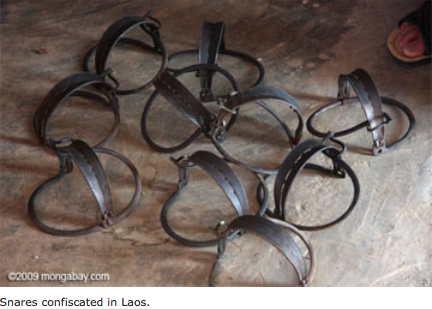 Laurel Neme: Why is that? You often hear a lot about the Chinese government making different seizures and arrests related to tigers. And so I guess I wanted to talk about both regular enforcement issues and also why isn’t there enforcement to shut down tiger farms?
Laurel Neme: Why is that? You often hear a lot about the Chinese government making different seizures and arrests related to tigers. And so I guess I wanted to talk about both regular enforcement issues and also why isn’t there enforcement to shut down tiger farms?
Grace Ge Gabriel: There have been enforcement actions particularly by customs and border police in border regions and to confiscate smuggled wild tiger parts. However, when it comes to enforcement to shut down the tiger bone wine trade, the lack of enforcement has a lot to do with, number one, as I said that grey area, the conflict within the wildlife protection law. Since the law allows them to captive breed for commercial purposes, and these places can say they are operating according to the law.
Also there is a lot of money involved. These are pretty big corporations… [At one] tiger farm there are 400 huge vats, each containing a tiger carcass. The price of the wine is based on how long [the tiger carcass] has been soaked in that vat. So [with] one tiger carcass, [the farm] can generate hundreds and thousands of dollars. They can soak it for a few years and they can claim it as a five-year wine, or they can claim it as a ten-year wine. And each bottle sells for $100 or more. So there’s a lot of money involved in that. I wouldn’t rule out the possibility of corruption and protection of local business.
Laurel Neme: And can they also claim that the animals died naturally and so they are using a byproduct?
Grace Ge Gabriel: They can but, according to the State Council trade ban, even if it died of natural death, the tiger bone stockpile is supposed to be sealed.
Another important issue is CITES. CITES has listed tigers as an Appendix I species, so all of the international commercial trade [in tiger parts and derivatives] is banned. And since then CITES has also come up with a resolution at it’s 12th Conference of the Parties [in 2002], and within the resolution it’s urging the parties to destroy stockpiles of tiger bone, [but] I have yet to see any destruction of tiger bone stockpiles…
Laurel Neme: And what has happened since then? The stockpiles have not been destroyed. Is that correct?
Grace Ge Gabriel: Correct. I have seen the destruction of tiger pelts confiscated at border regions but I have yet to see a tiger bone stockpile being destroyed. And, the fact is, a lot of these tiger farms, they do say we’ve got 2,000 tiger carcasses in the freezer and each of them is worth gold, tons of gold, and why can’t we use them. Having these tiger carcasses and stockpile stored there, it does give people ideas to use them.
Laurel Neme: More recently, at the most recent [15th] Conference of the Parties [in March 2010], there’s been a proposal related to the use of tigers on these farms. Can you talk a little bit about that?
Grace Ge Gabriel: Yes. While these tiger farm businesses, while they are already selling tiger bone wine, they are also lobbying the Chinese government to lift the trade ban. So in 2007, at the 14th CITES Conference of the Parties, the Chinese government had indicated that they are looking at lifting the trade ban, they are evaluating their policies. And so at that conference, China’s declaration of possibly lifting the trade ban had got the world worried. In today’s China, with the economic development, with the consuming power of Chinese consumers, if today we lifted the trade ban it would mean the extinction of wild tigers. No question about it.
And so at the CITES 14th Conference of the Parties, CITES Parties agreed to a series of decisions, one of which was to urge parties not to breed tigers for the trade of their parts or derivatives. And another decision was urging parties, if they were breeding tigers, then they need to keep tiger numbers at a level that would only benefit wild tiger conservation and otherwise they shouldn’t be keeping or breeding so many tigers. There were also decisions to increase law enforcement. There was also a decision urging parties that are evaluating their policies to take into consideration the previous CITES resolution on the trade control of tigers (Conf. 12.5). So all these decisions were adopted at CITES COP14. However, unfortunately, decisions are only good between the CITES conferences. So at [the March 2010 CITES] Conference of the Parties, … EU has put in a proposal to strengthen the CITES conference resolution 12.5 by including some of the languages adopted as a decision at the last conference…
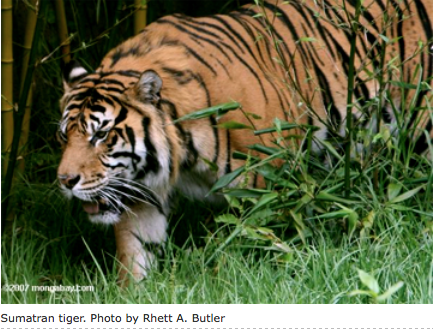 Laurel Neme: There are a lot of plans you mentioned about keeping the numbers solely for in the tiger farms at the levels that would be appropriate for conservation. Can these tigers be released into the wild?
Laurel Neme: There are a lot of plans you mentioned about keeping the numbers solely for in the tiger farms at the levels that would be appropriate for conservation. Can these tigers be released into the wild?
Grace Ge Gabriel: No they can’t. In fact, these tigers are so genetically compromised. They are crossbred, they are inbred, and also they just do not have the skills to survive in the wild. If they are released into any of the open areas, first of all there is no habitat for them and no prey. And if there is prey, these tigers, they don’t even know how to kill. They have been trying to kill as a group, but tigers are solitary predators. So these tigers, if they are released, most likely they will go into the surrounding communities and pose a threat to people and to livestock, which means death to them. And also they are genetically so compromised it would be a disaster if they ever were released into places where there are wild tigers.
Laurel Neme: And you had mentioned they are used to eating livestock, chickens and cows and things, so that’s what they would go after, presumably.
Grace Ge Gabriel: Exactly. And if they go after livestock it’s very easy to assume that they will be killed.
Laurel Neme: There’s been a lot of debate over whether legalizing the trade increases or decreases demand for products. So I wanted to talk a little bit about that. That if the proposal was not to go through, would that hurt or help wild tigers to create a captive-bred market for tiger products?
Grace Ge Gabriel: Poaching will be always be more cost competitive than farming a tiger for trade. The profit margin for poaching is much, much higher than farming a tiger. You raise a tiger on farm, it costs thousands of dollars—to feed this tiger meat, enclosure costs, the staff costs, the people costs—versus hunting and killing a tiger in the wild. It’s a very crude wire trap or a drop of poison or a bullet, even if you calculate in the cost of bribes and transport and possibly jail sentence for the trader. A lot of times these illegal traders, it’s very, very easy for them to smuggle a poached wild tiger into the market and the profit margin would be so much higher.
Laurel Neme: Is it even possible to distinguish between farmed tigers and wild tigers in the trade?
Grace Ge Gabriel: It’s even hard to distinguish whether this wine has tiger bone or doesn’t have tiger bone, let alone distinguishing if this bone is coming from tiger, is it coming from lion, from legal, from farmed tiger, or from wild tiger. It’s impossible, and again who is going to bear the burden of proving that.
Laurel Neme: I wanted to get back to the issue of enforcement. Are there any estimates of how much is being illegally traded? Can you talk about some of the recent seizures by China and other Asian countries.
Grace Ge Gabriel: Just last week there was a seizure in Nepal of tiger pelts, and there are seizures almost every week from across the tiger’s range. Since this trade is illegal it is very, very difficult to estimate how large or how much it costs. But according to customs organization, seizures only represent at most ten percent of the actual illegal trade. So… almost every week and I’ll use another example of India. The mortality rate of India’s wild tigers last year increased by 20 percent, and the Russian tiger population, the Amur tiger population in Russia’s Far East, for a long time scientists and conservationists were happy that that population has been stable. And it has been stable because of the trade ban, because the law enforcement agencies in the areas were effective. However, in the past, just last year a WCS survey indicated that Amur tiger population may have declined 30 to 40 percent in the past five years.
Laurel Neme: You had talked a lot about reducing demand and the Chinese government’s efforts to reduce the demand for tiger parts in traditional medicine, and I’m wondering about other types of public awareness campaigns that either you in IFAW, or the International Tiger Coalition or others are doing to reduce demand for tiger parts?
Grace Ge Gabriel: There has been some public awareness. In the 1990s, when the trade ban was first put into place, I think at that time even the Chinese government started a public awareness campaign and putting the “do not buy tiger products” on the labels of a lot of TCM products and organizing education conferences with the TCM industry. However, in the past few years, and I think it coincides with these farms are getting so many tigers and they are pushing the government to lift the trade ban and there haven’t been any public awareness in China done by the government for at least for the last 5-6 years.
 However, there are a few organizations that are at least doing public awareness in China. Wild Aid, for instance, has done a lot of using celebrities to do PSAs, urging celebrities such as Jackie Chan and Yao Ming, to do PSAs urging Chinese not to use tiger parts. And IFAW also started a website. In fact, we feel that a lot of the education not to use tiger parts were done from outside into China—people trying to tell Chinese “what not to do” and “what to do,” So we supported a group of Chinese conservationists and set up a website called “Love Tiger” website and the website is developed by Chinese and speaking to Chinese in Chinese. The website has got the support of a lot of Chinese famous artists, famous writers and they write blogs on the website and urging Chinese consumers and basically reminding them of the significance of tiger in our culture and reminding us that we shouldn’t push tigers to become extinct. It’s an animal in our Zodiac and we still have this animal and we don’t want it to become a dragon which is non-existent.
However, there are a few organizations that are at least doing public awareness in China. Wild Aid, for instance, has done a lot of using celebrities to do PSAs, urging celebrities such as Jackie Chan and Yao Ming, to do PSAs urging Chinese not to use tiger parts. And IFAW also started a website. In fact, we feel that a lot of the education not to use tiger parts were done from outside into China—people trying to tell Chinese “what not to do” and “what to do,” So we supported a group of Chinese conservationists and set up a website called “Love Tiger” website and the website is developed by Chinese and speaking to Chinese in Chinese. The website has got the support of a lot of Chinese famous artists, famous writers and they write blogs on the website and urging Chinese consumers and basically reminding them of the significance of tiger in our culture and reminding us that we shouldn’t push tigers to become extinct. It’s an animal in our Zodiac and we still have this animal and we don’t want it to become a dragon which is non-existent.
